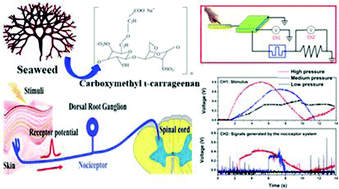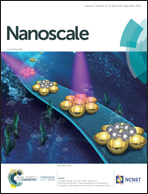Flexible artificial nociceptor using a biopolymer-based forming-free memristor†
Abstract
The development of electronic devices possessing the functionality of a nociceptor is a crucial step toward electronic receptors that can transfer the external stimuli to the internal nerve system. Of the various materials that have been used to realize artificial nociceptors, biopolymers have the advantages of being abundant, inexpensive, biocompatible, and flexible. In this study, nociceptor behaviors are demonstrated by the flexible Ag/carboxymethyl ι-carrageenan/ITO/PET forming-free memristors for the electronic receptors. The flexible carboxymethyl ι-carrageenan-based memristor showed threshold switching characteristics with a high ION/IOFF ratio of ∼104 and good switching endurance (>1.5 × 105 cycles). It also showed high bending endurance over 1000 cycles when measured in both the flat and the maximum bending conditions. More importantly, it differs from other common sensory receptors with its key features and functions, including threshold, relaxation, allodynia and hyperalgesia behaviors. Such nociceptive behaviors are attributed to the formation and spontaneous rupture of the Ag filament with diffusive dynamics. Finally, we built a pressure sensory alarm system by using our artificial nociceptor devices.



 Please wait while we load your content...
Please wait while we load your content...